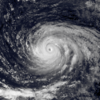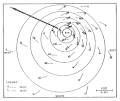Portal:Tropical cyclones
The Tropical Cyclones Portal

A tropical cyclone is a storm system characterized by a large low-pressure center, a closed low-level circulation and a spiral arrangement of numerous thunderstorms that produce strong winds and heavy rainfall. Tropical cyclones feed on the heat released when moist air rises, resulting in condensation of water vapor contained in the moist air. They are fueled by a different heat mechanism than other cyclonic windstorms such as Nor'easters, European windstorms and polar lows, leading to their classification as "warm core" storm systems. Most tropical cyclones originate in the doldrums, approximately ten degrees from the Equator.
The term "tropical" refers to both the geographic origin of these systems, which form almost exclusively in tropical regions of the globe, as well as to their formation in maritime tropical air masses. The term "cyclone" refers to such storms' cyclonic nature, with anticlockwise rotation in the Northern Hemisphere and clockwise rotation in the Southern Hemisphere. Depending on its location and intensity, a tropical cyclone may be referred to by names such as "hurricane", "typhoon", "tropical storm", "cyclonic storm", "tropical depression" or simply "cyclone".
Types of cyclone: 1. A "Typhoon" is a tropical cyclone located in the North-west Pacific Ocean which has the most cyclonic activity and storms occur year-round. 2. A "Hurricane" is also a tropical cyclone located at the North Atlantic Ocean or North-east Pacific Ocean which have an average storm activity and storms typically form between May 15 and November 30. 3. A "Cyclone" is a tropical cyclone that occurs in the South Pacific and Indian Oceans.
Selected named cyclone -
Typhoon Man-yi, known in the Philippines as Super Typhoon Pepito, was a powerful and long-tracked tropical cyclone that impacted the Philippines in mid–November 2024. Closely following Tropical Storm Trami and Typhoons Kong-rey, Yinxing, Toraji and Usagi, Man-yi became the sixth and final consecutive tropical system to affect the country in less than a month. It was also part of the four tropical cyclones to simultaneously exist in the Western Pacific during the month of November, the first occurrence since records began in 1951; the other three were Yinxing, Toraji, and Usagi.
The twenty-fourth named storm, the third violent typhoon of the season, and the sixth super typhoon of the annual typhoon season, Man-yi originated from an area of convection 220 km (140 mi) east of Kwajalein Atoll on November 8. Satellite imagery showed a more organized low-level circulation center and persistent deep convection on the southwestern periphery. As the system moved northwestward, the Japan Meteorological Agency (JMA) upgraded it to a tropical storm, naming it Man-yi, as the system passed Guam on November 13. After spending several days as a tropical storm, the JMA upgraded it to a minimal typhoon on November 15, with the Joint Typhoon Warning Center (JTWC) following shortly thereafter. Early the next day, the JMA reported that the storm reached its peak intensity with ten-minute sustained winds of 195 km/h (120 mph) and a central pressure of 920 hPa (27.17 inHg). It subsequently peaked as a Category 5-equivalent super typhoon on the Saffir-Simpson scale, with one-minute sustained winds of 260 km/h (160 mph). As it moved west-northwestward, Man-yi made its first landfall in Panganiban, Catanduanes, later the same day. After making landfall in Catanduanes, the system slightly degraded in appearance, with the western half becoming less organized as it passed north of the Calaguas Islands. The eye of the typhoon had become more distinct, and its structure seemed to have recovered, with the development of a secondary eyewall, suggesting that the system was undergoing an eyewall replacement cycle, although the cycle could not be completed. The following day, Man-yi made its second landfall in Dipaculao, Aurora, on Luzon Island. The typhoon accelerated northwestward over the South China Sea, with its low-level circulation center partially exposed and fragmented convective bands occurring along the southern and eastern edges of the system. However, the storm rapidly deteriorated as it encountered a low-level northeasterly cold surge across the northern South China Sea and experienced increased vertical wind shear. The JMA continued to monitor it until it was last noted on November 20. (Full article...)
Selected article -
Tropical cyclone forecasting is the science of forecasting where a tropical cyclone's center, and its effects, are expected to be at some point in the future. There are several elements to tropical cyclone forecasting: track forecasting, intensity forecasting, rainfall forecasting, storm surge, tornado, and seasonal forecasting. While skill is increasing in regard to track forecasting, intensity forecasting skill remains unchanged over the past several years. Seasonal forecasting began in the 1980s in the Atlantic basin and has spread into other basins in the years since. (Full article...)
Selected image -

Selected season -

The 2002 Pacific hurricane season was an average season which produced fifteen named storms. Eight hurricanes formed, including a record-equaling three Category 5 hurricanes, a record it shares with the 1994 and 2018 seasons. It was also a near-average season in terms of accumulated cyclone energy (ACE), having an ACE of 125. The season officially began on May 15, 2002 in the East Pacific Ocean, and on June 1, 2002 in the Central Pacific; both ended on November 30. These dates conventionally delimit the period of each year when most tropical cyclone formation occurs in these regions of the Pacific. The first system of the 2002 season, Hurricane Alma, formed on May 24, and the last, Tropical Depression Sixteen-E, dissipated on November 16.
The strongest hurricane of the season, Kenna, formed on October 22 and peaked as a Category 5 hurricane two days later. Land impact was relatively significant. Kenna made landfall near Puerto Vallarta, located in the Mexican state of Jalisco on October 25, killing four people. Kenna was, at the time, the second-most powerful hurricane to ever strike the western coast of Mexico, hitting with winds of 140 mph (220 km/h), as well as the strongest landfall in terms of windspeed until Hurricane Patricia in 2015. Elsewhere, Tropical Storm Julio made landfall in Mexico, and Tropical Storm Boris dumped torrential rain along the Mexican coast, despite remaining offshore. Hurricanes Elida and Hernan also reached Category 5 intensity, but neither caused any damage. Damage across the basin reached $101.23 million (2002 USD), while 7 people were killed by Julio and Kenna. (Full article...)
Related portals
Currently active tropical cyclones

Italicized basins are unofficial.
- North Atlantic (2025)
- No active systems
- East and Central Pacific (2025)
- No active systems
- West Pacific (2025)
- No active systems
- North Indian Ocean (2025)
- No active systems
- Mediterranean (2024–25)
- No active systems
- South-West Indian Ocean (2024–25)
- No active systems
- South Pacific (2024–25)
- No active systems
- South Atlantic (2024–25)
- No active systems
Last updated: 18:24, 5 March 2025 (UTC)
Tropical cyclone anniversaries

March 5
- 1995 - Cyclone Violet reached peak strength as a Category 3 severe tropical cyclone east of Australia.
- 2002 - Typhoon Mitag (pictured) with 1-minute sustained winds of 260 km/h (160 mph), the first ever recorded March super typhoon in the Western Pacific.
- 2021 - Cyclone Niran was the strongest storm of the 2020-21 Australian Region cyclone season, peaking with 260 km/h (160 mph).

March 6
- 1988 - The remnants of Cyclone Bola started bringing rainfall to New Zealand, where the storm killed three people and left US$82 million in damage.
- 2021 - Cyclone Niran (pictured) brushed the southern coast of New Caledonia, resulting in US$200 million in damage.

March 7
- 2004 - Cyclone Gafilo (pictured) made landfall in Madagascar near Antalaha near its peak intensity of 895 hPa (mbar), a South-West Indian Ocean record low. Gafilo killed 363 people on the island and left US$250 million in damage.
- 2017 - Cyclone Enawo struck northeastern Madagascar and moved southward through the island; it killed 78 people.
Did you know…




- …that the Joint Typhoon Warning Center considers that Typhoon Vera (pictured) of 1986 is actually two distinct systems, formed from two separated low-level circulations?
- …that Cyclone Freddy (track pictured) in 2023 was the longest-lasting tropical cyclone recorded?
- …that the typhoons of 2024—Yinxing, Toraji, Usagi, and Man-yi (pictured)—made history as the first recorded instance since 1951 of four tropical cyclones coexisting in November?
- …that Hurricane Otis (pictured) in 2023 was the first Pacific hurricane to make landfall at Category 5 intensity and surpassed Hurricane Patricia as the strongest landfalling Pacific hurricane on record?
General images -
The list of North Carolina hurricanes before 1900 encompasses 139 tropical cyclones that affected the U.S. state of North Carolina. Collectively, cyclones in North Carolina during the time period resulted in over 775 direct fatalities during the period. Seven cyclones affected the state in the 1893 season, which was the year with the most tropical cyclones impacting the state during the time period. From the beginning of the official North Atlantic hurricane record in 1851 to 1899, there were 12 years without a known tropical cyclone affecting the state. The strongest hurricane to hit the state during the official record was the San Ciriaco hurricane of 1899, which struck the state with winds of 120 mph (195 km/h), although the 1821 Norfolk and Long Island Hurricane may have been stronger.
Historical data prior to 1700 is sparse due to lack of significant European settlements along the coastline; the few storms listed are largely records from Roanoke Colony and later the Province of Carolina. Modern meteorologists believe early storms were tropical cyclones, though due to the time period confirmation is impossible. One theory explaining the disappearance of Roanoke Colony suggests a hurricane destroyed the village, though there is no evidence to prove the theory. It is considered unlikely due to lack of damage to a fence around the village, on which the villagers left an inscription. (Full article...)
Topics
Subcategories
Related WikiProjects
WikiProject Tropical cyclones is the central point of coordination for Wikipedia's coverage of tropical cyclones. Feel free to help!
WikiProject Weather is the main center point of coordination for Wikipedia's coverage of meteorology in general, and the parent project of WikiProject Tropical cyclones. Three other branches of WikiProject Weather in particular share significant overlaps with WikiProject Tropical cyclones:
- The Non-tropical storms task force coordinates most of Wikipedia's coverage on extratropical cyclones, which tropical cyclones often transition into near the end of their lifespan.
- The Floods task force takes on the scope of flooding events all over the world, with rainfall from tropical cyclones a significant factor in many of them.
- WikiProject Severe weather documents the effects of extreme weather such as tornadoes, which landfalling tropical cyclones can produce.
Things you can do
 |
Here are some tasks awaiting attention:
|
Wikimedia
The following Wikimedia Foundation sister projects provide more on this subject:
-
Commons
Free media repository -
Wikibooks
Free textbooks and manuals -
Wikidata
Free knowledge base -
Wikinews
Free-content news -
Wikiquote
Collection of quotations -
Wikisource
Free-content library -
Wikiversity
Free learning tools -
Wikivoyage
Free travel guide -
Wiktionary
Dictionary and thesaurus























































